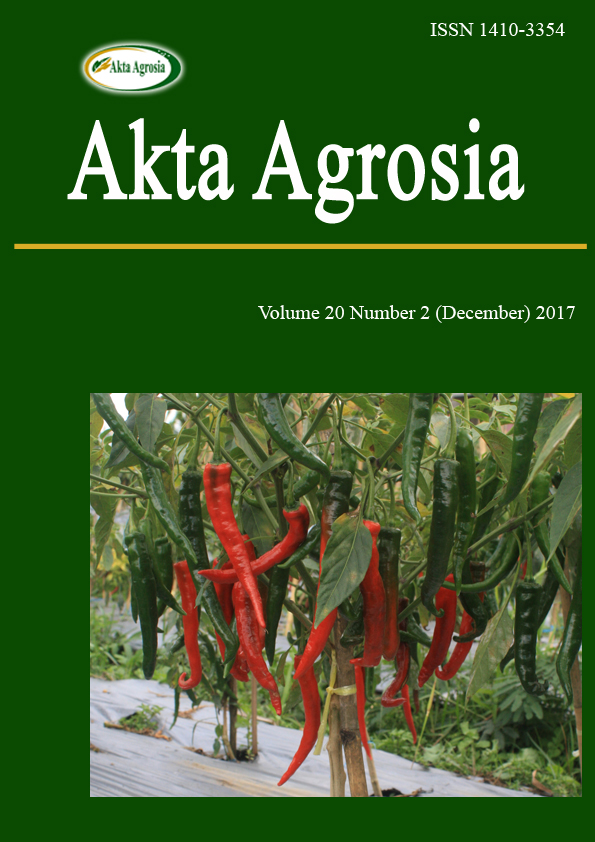Main Article Content
Abstract
Bambara groundnut (Bogor groundnut) was an alternative food crops having high nourishing, better taste and bigger size nut than the soy beans and peanuts. To meet the need for food and industrial needs, the program to increase production of Bogor groundnut was required, one of which is the use of peat as a growing medium using the technology of mixing peat and mineral soil. The research objective was to obtain a mixture of peat with mineral soil and dolomite lime dose suitable for the highest growth and yield of Bogor groundnut. This study was conducted in May 2015-September 2015 in the Greenhouses of Faculty of Agriculture, University of Bengkulu. The experiment was arranged in a completely slot deposit 5000 randomized design (CRD) with two treatment factors and three replications. The first factor was soil mix of peat and mineral soil (G0: 100% peat + 0% mineral soil; G1: 75% peat + 25% mineral soil; G2: 50% peat + 50% mineral soil; G3: 25% peat + 75% mineral soil) and the second factor was the dose of dolomite (D0: without lime dolomite; D1: 3 ton ha-1 and D2: 4 ton ha-1). The results showed that the response of biomass dry-weight to a mixture of peat with mineral soil was influenced by the dose of dolomite, but there was no interaction on other variables. Treatment of a mixture of peat 100% alone was capable of generating the highest number of leaf, biomass fresh- and dry-weight. Bogor groundnut plants showed the same response to the dose variation of dolomite lime.
Keywords: Bogor groundnut, peat, mineral, dolomite
Article Details
Copyright (c) 2017 Inggi Pamungkas, Edhi Turmudi, Kanang Setyo Hindarto

This work is licensed under a Creative Commons Attribution-ShareAlike 4.0 International License.
Authors who publish with this journal agree to the following terms:
- Authors retain copyright and grant the journal right of first publication with the work simultaneously licensed under a Creative Commons Attribution License that allows others to share the work with an acknowledgement of the work's authorship and initial publication in this journal.
- Authors are able to enter into separate, additional contractual arrangements for the non-exclusive distribution of the journal's published version of the work (e.g., post it to an institutional repository or publish it in a book), with an acknowledgement of its initial publication in this journal.
- Authors are permitted and encouraged to post their work online (e.g. in institutional repositories or on their website) prior to and during the submission process, as it can lead to productive exchanges, as well as earlier and greater citation of published work (See The Effect of Open Access).
References
- Agus, F., R.D. Yustika dan U. Haryati. 2006. Determination of land volume weight. Jurnal Sifat Fisik Tanah dan Metode Analisis. 03 : 25-26 (In Indonesian)
- Anwar, K and M. Alwi. 2000. Lime Application to Increase Soybean Yield on Peat Land. Jakarta: Departemen Pertanian, Pusat Penelitian dan Pengembangan Pertanian. (In Indonesian)
- Barchia, M.F. 2006. Peat. Yogyakarta: Gadjah Mada University Press. (In Indonesian)
- Barhanudin and Nurmansyah. 2010. The influence of giving fertilizer and lime on the growth and patchouli production on yellow red podzolik land. Buletin Littro. 21(2):138-144. (In Indonesian)
- Darmawijaya, I. 1990. Soil Classification: Fundamentals of Theory for Soil Research and Implementation of Research. Yogyakarta: Gadjah Mada University Press. (In Indonesian)
- Madamba, R. 1995. Breeding bambara groundnut varieties suitable for Zimbabwean Conditions. pp. 128-134. In Proceedings of the Workshop on Conservation and Improvement of Bambara Groundnut (Vigna subterranea (L.) Verdc.). Zimbabwe 14-16 November 1995.
- Prasetyo, B.H., D. Subardja dan B. Kaslan. 2005. Ultisols from Andesitic volcano ingredients on the slopes of Ungaran mountain. Jurnal Tanah dan Iklim (23):1-12. (In Indonesian)
- Redjeki, E.S. 2003. Gender analysis on the contribution of women farmer of Bogor groundnut to increased family income. Jurnal Fakultas Pertanian, Universitas Muhammadiyah Gresik. (In Indonesian)
- Rukmana, R and Y.Y. Oesman. 2001. Bogor Groundnut: Cultivation and Prospect of Farming. Yogyakarta: Kanisius. (In Indonesian)
- Saleh, B. 1999. Agricultural Commodity Test Results on Peat Land. Makalah Seminar. Bengkulu: Fakultas Pertanian, Universitas Bengkulu. (In Indonesian)
- Soepardi, 2001. Strategy of Agribusiness Farmers Based on Land Resources. Prosiding Nasional Pengelolaan Sumber daya Lahan dan Pupuk, 35-52. (In Indonesian)
References
Agus, F., R.D. Yustika dan U. Haryati. 2006. Determination of land volume weight. Jurnal Sifat Fisik Tanah dan Metode Analisis. 03 : 25-26 (In Indonesian)
Anwar, K and M. Alwi. 2000. Lime Application to Increase Soybean Yield on Peat Land. Jakarta: Departemen Pertanian, Pusat Penelitian dan Pengembangan Pertanian. (In Indonesian)
Barchia, M.F. 2006. Peat. Yogyakarta: Gadjah Mada University Press. (In Indonesian)
Barhanudin and Nurmansyah. 2010. The influence of giving fertilizer and lime on the growth and patchouli production on yellow red podzolik land. Buletin Littro. 21(2):138-144. (In Indonesian)
Darmawijaya, I. 1990. Soil Classification: Fundamentals of Theory for Soil Research and Implementation of Research. Yogyakarta: Gadjah Mada University Press. (In Indonesian)
Madamba, R. 1995. Breeding bambara groundnut varieties suitable for Zimbabwean Conditions. pp. 128-134. In Proceedings of the Workshop on Conservation and Improvement of Bambara Groundnut (Vigna subterranea (L.) Verdc.). Zimbabwe 14-16 November 1995.
Prasetyo, B.H., D. Subardja dan B. Kaslan. 2005. Ultisols from Andesitic volcano ingredients on the slopes of Ungaran mountain. Jurnal Tanah dan Iklim (23):1-12. (In Indonesian)
Redjeki, E.S. 2003. Gender analysis on the contribution of women farmer of Bogor groundnut to increased family income. Jurnal Fakultas Pertanian, Universitas Muhammadiyah Gresik. (In Indonesian)
Rukmana, R and Y.Y. Oesman. 2001. Bogor Groundnut: Cultivation and Prospect of Farming. Yogyakarta: Kanisius. (In Indonesian)
Saleh, B. 1999. Agricultural Commodity Test Results on Peat Land. Makalah Seminar. Bengkulu: Fakultas Pertanian, Universitas Bengkulu. (In Indonesian)
Soepardi, 2001. Strategy of Agribusiness Farmers Based on Land Resources. Prosiding Nasional Pengelolaan Sumber daya Lahan dan Pupuk, 35-52. (In Indonesian)
